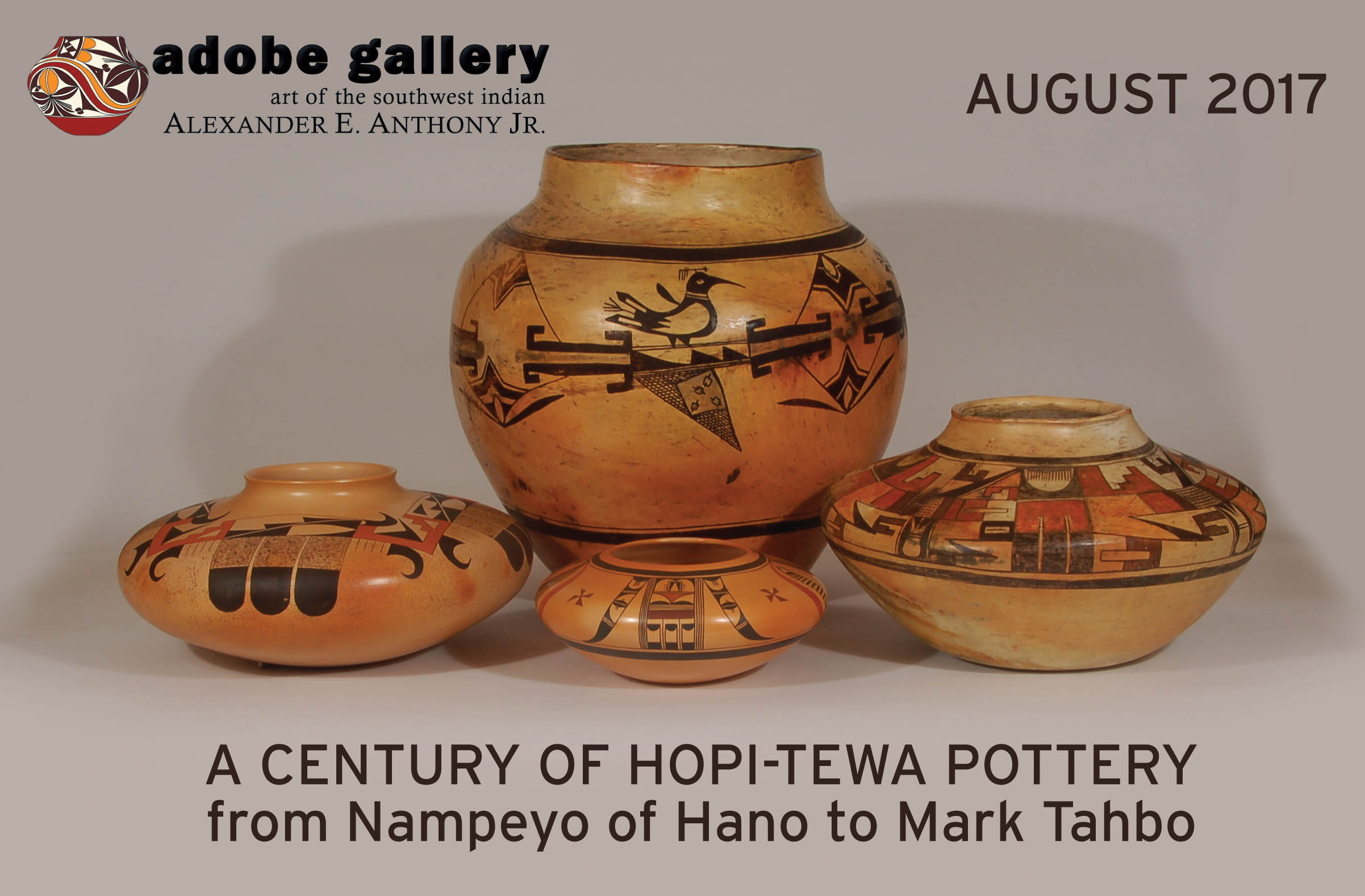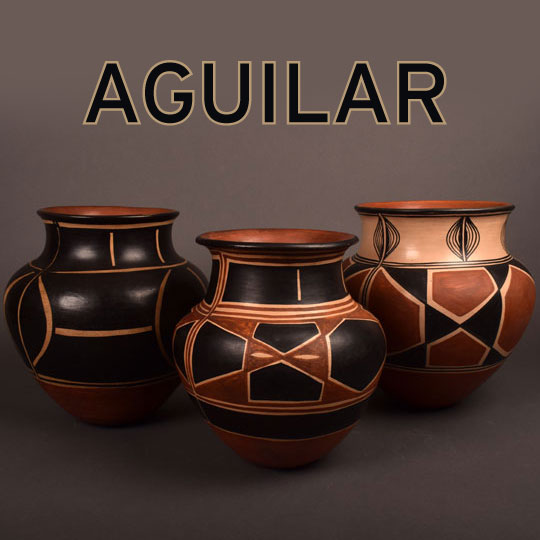Beyond Utility: The Sacred Art of Pueblo Pottery
When pottery is referred to as "utilitarian," it often overlooks the pueblo people's perspective. While pottery may serve utilitarian purposes, it holds deeper meanings for the potters. They do not view their vessels as mere utensils. This is evident in the time and effort potters invested in beautifying a water jar, treating each vessel as a sacred gift from Mother Earth.
The use of the terms "prehistoric," "historic," and "utilitarian" is not necessarily wrong or insensitive, provided we understand them as descriptive terms and acknowledge the significance of vessels at the pueblo, beyond their utilitarian function. As collectors, we admire the beauty of a vessel with its elaborate designs and appreciate the effort put into making it so.
The Song of the Lark
From Women and Vessels in The Song of the Lark and Shadows on the Rock
by ANGELA CONRAD
Their pottery was the most direct appeal to water, the envelope and sheath of the precious element itself" (334). Sharon O'Brien explains how during her sojourn in the canyon, Willa Cather, too, "felt herself recipient of a mode of creativity marked by receptivity rather than self-assertion" (415). She was, according to Sergeant, interested in the ancient women who "under conditions of incredible difficulty" had "made beautiful objects for daily use out of riverbottom clay" (O'Brien 415). Thus when Thea's revelation about art hits her, it is closely tied to the idea of women and spirituality:
The stream and the broken pottery: what was art but an effort to make a sheath, a mould in which to imprison for a moment the shining, elusive element which is life itself,-life hurrying past us and running away. . . . The Indian women had held it in their jars. In singing, one made a vessel of one's throat and nostrils and held it on one's breath, caught the stream in a scale of natural intervals. (334-35)
- Willa Cather The Song of the Lark (1915)
https://cather.unl.edu/scholarship/catherstudies/11/cs011.conrad
What is a Heartline?
The heartline is used primarily by Zuni Pueblo potters and can be seen in many animals – usually a deer, called a Heartline Deer. The line from the mouth to the heart signifies the "breath of life."
GROUNDED IN CLAY the spirit of Pueblo Pottery
GROUNDED IN CLAY the spirit of Pueblo Pottery (go there now)
Grounded in Clay is a collaborative exhibit curated by the Pueblo Pottery Collective and organized by the School for Advanced Research and New York's Vilcek Foundation. The School for Advanced Research, a not-for-profit educational institution, was established in 1907 to advance innovative social science and Native American art. Its 15-acre residential campus sits on ancestral lands of the Tewa people in O'gah'poh geh Owingeh or Santa Fe, New Mexico.
Native American Heritage Day
 anIt is Black Friday but, more importantly, it is Native American Heritage Day, celebrated annually on the day after Thanksgiving, this year November 25, 2022. It is a day we celebrate the lives of our Native American population and, for many of us, a reminder to look at our collections of Native American art, whether it's a collection of pueblo pottery, Navajo textiles, Native jewelry, Hopi Katsina dolls, Zuni fetishes, or many other beautiful and meaningful creations we appreciate today as art objects.
anIt is Black Friday but, more importantly, it is Native American Heritage Day, celebrated annually on the day after Thanksgiving, this year November 25, 2022. It is a day we celebrate the lives of our Native American population and, for many of us, a reminder to look at our collections of Native American art, whether it's a collection of pueblo pottery, Navajo textiles, Native jewelry, Hopi Katsina dolls, Zuni fetishes, or many other beautiful and meaningful creations we appreciate today as art objects.
What is Warp and Weft?

In weaving, the weft (sometimes woof) is the term for the thread or yarn which is drawn through, inserted over-and-under, the lengthwise warp yarns that are held in tension on a frame or loom to create cloth. Warp is the lengthwise or longitudinal thread in a roll, while weft is the transverse thread. A single thread of the weft, crossing the warp, is called a pick. Terms do vary (for instance, in North America, the weft is sometimes referred to as the fill or the filling yarn). Each individual warp thread in a fabric is called a warp end or end. The weft is a thread or yarn usually made of spun fibre. The original fibres used were wool, flax or cotton. Today, man-made fibres are often used in weaving. Because the weft does not have to be stretched on a loom in the way that the warp is, it can generally be less strong. The weft is threaded through the warp using a "shuttle", air jets or "rapier grippers." Hand looms were the original weaver's tool, with the shuttle being threaded through alternately raised warps by hand. A useful way of remembering which is warp and which is weft is: 'one of them goes from weft to wight'. -Wikipedia
More specifically:
"All twill weaves are produced by floating the weft elements over more than one warp at a time to create a raised pattern of color and texture. Three twill-weave techniques were used by both Navajo and Pueblo weavers: plain twill forming diagonal floats; herringbone twill, in which the diagonal floats alternate direction to form a vertical zigzag or chevron pattern; and a diamond twill, in which the herringbone patterns are woven in such a manner as to create concentric diamond patterns." Reference: Kaufman, Alice and Christopher Selser. The Navajo Weaving Tradition 1650 to the Present: page 138.
Visit Canyon Road in Santa Fe
Santa Fe is a small city but has third largest art market in the United States.
It's easy to be overwhelmed by the art scene in downtown Santa Fe. The small city has over 250 to 350 (depending on who counts) galleries with pieces ranging from classic to contemporary. One hundred of those galleries are on Canyon Road, including Adobe Gallery.
Follow Elaine Ritchel, a local art guide and owner of Santa Fe Art Tours, to see how to navigate through it all. Source: CNN
We recommend Santa Fe Art Tours (this will take you to their website) to learn more about its culture and art. It's something you can only achieve by walking and tours are tailored to your preferences.
Tradition and Innovation, Santa Clara artists Pablita Velarde and Helen Hardin
Mother-daughter artists Pablita Velarde and Helen Hardin drew from the traditions and imagery of their cultures in the expression of their distinctive yet similar works. At least 19 original paintings from the renowned painters are on view through April 30 at Adobe Gallery in Santa Fe, New Mexico, a celebration of the wide range of styles that the artists employed during their careers.
Velarde (1918-2006), born as “Tse Tsan” or “Golden Dawn” at the Santa Clara Pueblo in New Mexico, was known for her earth paintings. She used mineral and rock elements grounded on a metate and mano, resulting in a powdery substance that was the matter used in her paints. Velarde painted almost exclusively on paper supports, using watercolor and casein in addition to earth pigments, according to the gallery. For years, she worked in a studio she built herself, primarly with pigments she made herself.
Hardin (1943-1984), known as “Tsa-Sah-Wee-Eh” or “Little Standing Spruce,” in the Tewa language, was one of the pre-eminent painters of the 20th century. She saw her style emerge in the 1970s with katsina figure paintings. Her Woman Series works are considered deeply affective and concerned with the physical and intellectual struggle of the artist’s existence. As the gallery describes further, it is “the struggle of woman versus man, patron versus artist, Indian versus Anglo, tradition versus progression, an art of complexity and timeless beauty, a forward looking art yet rooted firmly in the ancient past.”
Al Anthony, owner of Adobe Gallery, says Hardin’s Santo Domingo Garden Bird represents the bird figure that the Santo Domingo artists place on their pottery. “I think maybe Helen just liked it and chose to use it,” he elaborates. “Acoma paint parrots on some of their pots. A lot of artists have reproduced the Acoma parrot.”
Remarkably different in style, Velarde’s Zuni Shalako Ceremony Witnessed by a Santa Clara Artist shows a view of the namesake Zuni ceremony occurring during the first week of December. A written description from the Ball State University website explains the process of preparing for Shalako: “The participants have been practicing all year to perform their duties; seven new houses have been built to welcome the Shalakos (the Giant Couriers of the Rainmakers) and the Longhorns (Rain Gods of the North), and an enormous amount of food is prepared for both residents and visitors. Shalako brings the old year to a close and welcomes the new year, and asks for rain, the propagation of plants and animals, and the health and well-being of its participants. It is also a re-enactment of various important tribal myths.”
Anthony describes it as an all-night, eight-day ceremony, with a public portion in the last day.
“It is basically the blessing of new homes, or remodeled homes,” he continues. “There are usually about four Shalakos, they are representing Gods. They are supernaturals. They are about 10 feet tall. When they build a new house, before they finish it, they leave the living room, or the one big room. They dig the floor down about 4 feet from ground level...They have to do that in order to accommodate their height.”
Anthony continues, “The next morning around sunrise, they have a race down the river. If one of them falls, they figure that is an omen of a disaster for the year. They’re human inside, holding up these 10-foottall structures.”
Ann Marshall, director of curation and education at the Heard Museum in Phoenix, remarks that the work of both artists “demonstrates a joy in experimenting with media and style. It is a quality of the best artists that they refuse to repeat a successful formula, but move on to explore new ways to express their vision.”
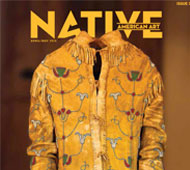
As seen in:
Native American Art, April-May 2016
A Century of Hopi-Tewa Pottery: From Nampeyo of Hano to Mark Tahbo
Legendary Hopi matriarch Nampeyo of Hano used designs created by her prehistoric ancestors to bring Hopi pottery to the masses in the early 1900s. Today, Hopi potters like Mark Tahbo use Nampeyo's designs as inspiration for their new works. This exhibit, which features works by both of these potters and many others who produced between them, will showcase the ways that today's artists continue to be influenced by those of yesteryear....
2017 Show Catalog: A Century of Hopi-Tewa Pottery: From Nampeyo of Hano to Mark Tahbo
A Century of Hopi-Tewa Pottery Catalog (free download and view now)
Aguilar Sisters Historic Pottery of Santo Domingo Pueblo 2019
At the turn of the twentieth century, Felipita Aguilar Garcia and Asunción Aguilar Caté—sisters from Santo Domingo Pueblo—were creating pottery in the traditional fashion of their people. The Aguilar sisters were skilled potters who produced fine examples of traditional Santo Domingo Black-on-cream pottery. At the time, the Santa Fe train stopped at Santo Domingo Pueblo, allowing the sisters and other Native artists to sell their works to visitors.
By 1910, the Aguilar sisters’ pottery sales had decreased significantly. They sought counsel from trader Julius Seligman, who was aware of their declining sales. Seligman suggested that they develop new designs. His specific suggestion was that they use more red than they had in the past. The Aguilar sisters accepted Seligman’s advice, began experimenting, and ultimately created two distinct versions of a new style of pottery that was more bold and modern-looking than standard Santo Domingo pottery. In one version, the decorated area is black with narrow cream-colored lines forming strong geometric patterns. In the other, the designs are of the same type, but in red and black with cream-colored outlines.
Most of the Aguilar sisters’ creations were water jars (or “tinajas”) and storage jars. It is known that they also produced bowls—a photograph dated 1912 shows a large Aguilar sisters dough bowl or large storage jar on a library table in the lobby of Lamy, New Mexico’s El Ortiz Hotel. (Taylor, 1987:220)
Seligman stocked his shelves with their new works, but there is no indication that sales increased. Their movement was strong but short-lived. It seems to have ended around 1915, most likely because of old age or illness. There is some disagreement as to the end of their careers, however. An unpublished text by Francis Harlow and Dwight Lanmon includes a handful of pieces by the Aguilar sisters, most of which are reported to date to 1910-1915. Chapman (p.152) states that two Black-on-red jars are known to have been made by one potter as late as 1920. He does not state the name of the potter, but it can be assumed that he was referring to one of the sisters. Douglas (1941) states that the two sisters passed away around 1915. Batkin (p.99) states that “evidence suggests that Felipita Garcia continued her style as late as 1920 to 1930; she also made traditional polychrome and Black-on-red vessels, all of them beautifully executed.”
We are attributing our collection to both Felipita and Asunción, as they are generally regarded as the creators of this style. We are unable to confidently attribute a certain style to a certain sister, and so are crediting the pair for the creation of these jars. It should be noted there was likely a third potter in the family who produced similar works—many of our reference materials mention a sister-in-law. Her name is inconsistent between various texts, and so we are unable to identify her with confidence. As is often the case with pueblo history, conflicting reports exist, and precise details are unknown. It is our sincere hope that records someday will permit the attribution of specific vessels to the hands of each of the Aguilar sisters, and possibly their sister-in-law as well. For now, we cannot make attributions with any degree of confidence. What we do know is that the Aguilar sisters’ pottery, both the old and new styles, slid into obscurity, save for recognition from the scholars mentioned above. Collectors who purchased their pieces were aware of neither the names of the makers nor the story behind the creation of the style.
When viewing these jars, one might assume that they were made much later than they were. That assumption would be reasonable, as they look very modern. The Aguilar sisters created a seamless blend of old and new that has aged very well in the century that has passed since its inception. Quite simply, they were ahead of their time. Like many truly innovative creators, their efforts were not recognized until much later. Despite being largely ignored during the era of their creation, the Aguilar sisters’ jars rank among the most important pueblo pottery pieces made during the early twentieth century.
Downloadable Digital Catalog of this Show
Pieces of the Past: Adobe Gallery’s Al Anthony and his passion for Pueblo pottery
 When Al Anthony talks about historic Pueblo pottery, the glow in his eyes suggests the same contained fire that baked so many of his showpieces in the indigenous kilns of the past. He's an ardent fan, and Adobe Gallery-the Canyon Road establishment he opened in 2001, after 23 years of operation in Albuquerque-is something of his shrine. Considered one of Santa Fe's leading Native American art galleries, Adobe is filled with contemporary Pueblo pottery, katsina dolls, baskets, paintings, and many other native objets d'art. But it's the historic Pueblo pottery Anthony loves so much that lends a distinctive archaeological air to the place. Lining shelves and perched on glass cases are weather-worn pots of various shapes and sizes, adorned with patterns and images and the traditional black, white, and burnt umber color scheme. "This pottery is phenomenally beautiful and ethnographically important," Anthony says. "Unlike pottery made to sell, these items were made to be used, and their evidence of use is especially appealing to collectors." Although Anthony's been a fixture on the Native American art scene for 34 years, he had little exposure to art, let alone Southwestern Indian art, for most of his life. Growing up in a small North Carolina town, he joined the U.S. Air Force to become a nuclear engineer. It wasn't until 1957, when he was stationed at Kirtland Air Force Base, that he first set eyes on a Pueblo pot.
When Al Anthony talks about historic Pueblo pottery, the glow in his eyes suggests the same contained fire that baked so many of his showpieces in the indigenous kilns of the past. He's an ardent fan, and Adobe Gallery-the Canyon Road establishment he opened in 2001, after 23 years of operation in Albuquerque-is something of his shrine. Considered one of Santa Fe's leading Native American art galleries, Adobe is filled with contemporary Pueblo pottery, katsina dolls, baskets, paintings, and many other native objets d'art. But it's the historic Pueblo pottery Anthony loves so much that lends a distinctive archaeological air to the place. Lining shelves and perched on glass cases are weather-worn pots of various shapes and sizes, adorned with patterns and images and the traditional black, white, and burnt umber color scheme. "This pottery is phenomenally beautiful and ethnographically important," Anthony says. "Unlike pottery made to sell, these items were made to be used, and their evidence of use is especially appealing to collectors." Although Anthony's been a fixture on the Native American art scene for 34 years, he had little exposure to art, let alone Southwestern Indian art, for most of his life. Growing up in a small North Carolina town, he joined the U.S. Air Force to become a nuclear engineer. It wasn't until 1957, when he was stationed at Kirtland Air Force Base, that he first set eyes on a Pueblo pot.
"I was wandering around downtown Albuquerque, and in a shop window I saw a black pot that just captivated me," Anthony recalls. Since he couldn't afford the $100 cost outright, the shopkeeper let him make 10 monthly payments of $10 each. Anthony collected for the next 19 years and, in 1978, two years after retiring from the Air Force, he opened Adobe Gallery in Albuquerque's Old Town, selling mostly contemporary pieces. In the mid-1980s, he was offered 13 historic Native pieces and, though he knew little about historic pottery at the time, his interest-and subsequent passion-was ignited. In 2001, Anthony moved shop north to Santa Fe, where he is now a very well respected, self-taught expert in historic Pueblo pottery. While Anthony dealt directly with Pueblo potters when he began his business, often driving out to the Pueblos to buy art, these days he is approached by art sellers on an almost daily basis. Many of his pieces come from the estates of longtime collectors across the country and from those looking to downsize, both of which provide a steady source for historic items. One of his recent acquisitions, a San Ildefonso Pueblo vessel made in 1889, came to Anthony through a phone call from a woman who runs estate sales. About the size of a large beach ball but with the considerably larger price tag of $85,000, the pot's belly features a series of images that tell the story, presumably, of a horse theft gone awry. One image depicts a man walking, horse at his side; another shows a second man riding into scene on horseback; lastly, the two men are shown fighting. The names "Juan" and "Jose" are scrawled on the vessel's body, but only "Juan" is on the lid above the date. "We assume the pot was made in Juan's honor," says Anthony. "We just don't know whether he won or lost the fight." That's a mystery that Anthony-and a future buyer-can live with. In fact, it's part of the vessel's allure. "The exciting thing for me is always when new stuff comes in," he says. "But I certainly enjoy what I have on display here."
by Ben Ikenson
Santa Fean Magazine, Aug-Sep 2022 (this link will download the interview insert from the magazine)
Adobe Gallery, Santa Fe, 45th Anniversary
At the foot of Canyon Road sits the small but mighty Adobe Gallery. Specializing in Native American work from the late-19th and early-20th centuries, the gallery’s collection is in constant flux, with new pieces being delivered daily. On a recent visit, a water bowl from Acoma Pueblo circa 1880 had just arrived.
Adobe Gallery is owned by Alexander E. Anthony, Jr., spry in all of his eighty-nine years of age. A former nuclear engineer in the U.S. Airforce, Anthony fell in love with the richness and breadth of New Mexican culture when he arrived here in 1957. He opened Adobe Gallery’s physical space in Albuquerque in 1978, eventually moving it to Canyon Road in 2001.
Anthony knows the collection inside and out and is quick to relay the origin story of each object in the gallery. In addition to rain bowls, the gallery features dough-mixing bowls, weavings, kachina dolls, jewelry, and paintings. The painting collection includes work by students who studied at the Santa Fe Indian School in the 1930s under Dorothy Dunn and other pivotal artists such as Tonita Vigil Peña, who was one of the first Native American women to be recognized as a painter.
Visiting Adobe Gallery feels like opening a treasure chest. The atmosphere is teeming with stories of artists, traditions, and provenance. The gallery celebrates its forty-fifth anniversary this summer, with the hopes of an Indian Market-adjacent opening and a party in the works.
Source: DAISY GEOFFREY, Southwest Contemporary (this link will take you to their website)
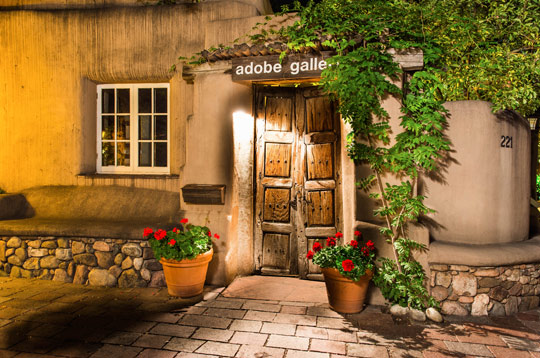
Historic Zuni Pottery Special Exhibit and Catalog 2008
An exhibit of historic Pueblo pottery and other art forms and older jewelry from Zuni Pueblo that occurred at Adobe Gallery on July 31, 2008 until September 01, 2008. The exhibit opens on Friday, May 2nd, with a reception from 4 to 6 pm, and continues through May 31st. Historic Zuni Pueblo Pottery from the mid-1800s to the mid 1900s will be the highlight of the exhibit with over 30 pieces available for purchase. The exhibit is in coordination with the release of a new 614-page book entitled “The Pottery of Zuni Pueblo” by Dwight P Lanmon.
View more details on the show.
 Download Exhibit Catalog:
Download Exhibit Catalog:
Historic Pottery of Zuni Pueblo
(click here to download
a .pdf version of this catalog.
The file size is 10.69MB.
and will take several seconds to download)
by Alexander E. Anthony, Jr.
(Available to download Now)
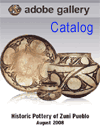 40-page Paperback Exhibit Catalog:
40-page Paperback Exhibit Catalog:
Historic Pottery of Zuni Pueblo
(view details of this catalog)
by Alexander E. Anthony, Jr.
(Available from Adobe Gallery)
A Brief History of Navajo and Pueblo Jewelry
This is an educational video produced and provided by The Authentic Tribal Art Dealers Association.
A Brief History of Navajo & Pueblo Jewelry from ATADA.org on Vimeo.
Navajo Weaving Tradition
This is an educational video produced and provided by The Authentic Tribal Art Dealers Association.
Navajo Weaving Tradition from ATADA.org on Vimeo.
Hopi Pueblo, Hopituh Shi-nu-mu, Second Mesa Basketry
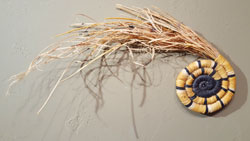 Hopi Pueblo, Hopituh Shi-nu-mu, Second Mesa Basketry is usually made from galleta grass and yucca. This is what is looks like during the coiling process. There is an interesting video that shows how this is done. Take a look.
Hopi Pueblo, Hopituh Shi-nu-mu, Second Mesa Basketry is usually made from galleta grass and yucca. This is what is looks like during the coiling process. There is an interesting video that shows how this is done. Take a look.
What is a Katsina?
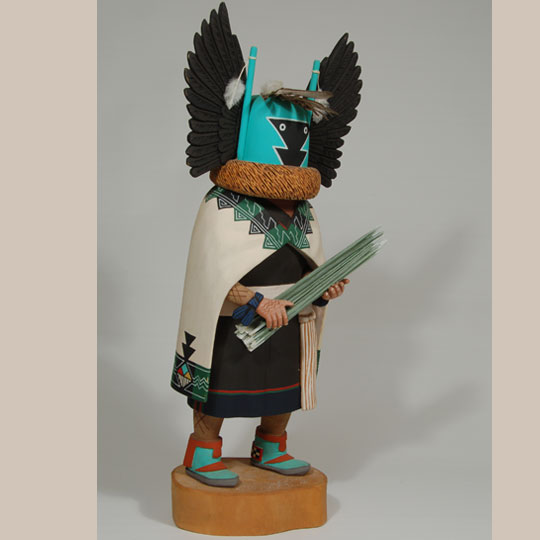 I have recently joined the team at Adobe Gallery, and through this, have been granted the wonderful opportunity to immerse myself in the history and culture of the Southwest. What a better way to do so than through our miraculous inventory of art! One question I am asked is, “What is a Katsina?” I would like to take the time to answer this question for those of you who, like me, are new to the spirituality of the Pueblo people and may be unfamiliar with their Katsina cult.
I have recently joined the team at Adobe Gallery, and through this, have been granted the wonderful opportunity to immerse myself in the history and culture of the Southwest. What a better way to do so than through our miraculous inventory of art! One question I am asked is, “What is a Katsina?” I would like to take the time to answer this question for those of you who, like me, are new to the spirituality of the Pueblo people and may be unfamiliar with their Katsina cult.
This question arises as clients view our inventory of Katsina dolls, however this is only one of three ways Katsinas are expressed. They are also and originally the supernatural deities themselves, and the masked dancers who represent Katsinas at religious ceremonies.
The dolls are really teaching tools, and are carefully carved by the Pueblo men and gifted to young girls, two per year, until she is of marrying age. The boys are given bows and arrows but are included in sacred Katsina ceremonies in the kivas to inaugurate them into the spiritual cult.
Each Katsina has a different meaning and purpose. Chief Katsina teach wisdom, female Katsinas teach values, ogres teach discipline, and clowns provide amusement paired with lessons. Others provide advice, warnings, and blessings. Each Katsina is seen as a powerful being who is not worshipped but if given admiration and respect, will use its particular power for the good of the people.
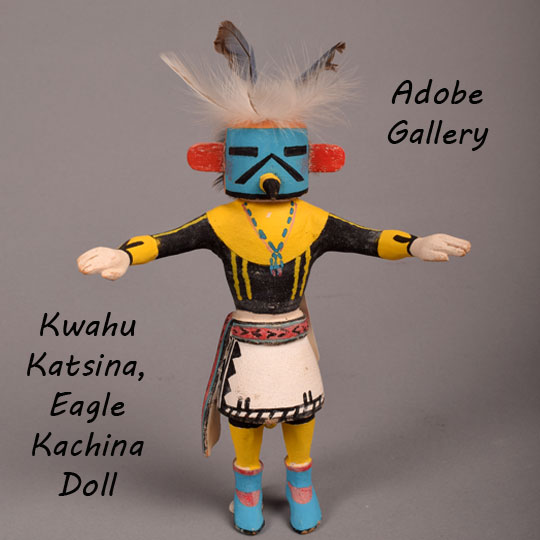 According to the Katsina myths, the Katsinas themselves first taught the people how to hunt, heal sickness, make tools and how to live off the land by planting crops and collecting plants. At some point in history, wars occurred and the Katsinas were killed off. Or, according to another version of the mythology, the Katsinas returned to the underworld when the people began to take them for granted. Before they left or were killed, they taught a select few men of great faith their ceremonies complete with instructions on how to make the affiliated sacred masks and costumes.
According to the Katsina myths, the Katsinas themselves first taught the people how to hunt, heal sickness, make tools and how to live off the land by planting crops and collecting plants. At some point in history, wars occurred and the Katsinas were killed off. Or, according to another version of the mythology, the Katsinas returned to the underworld when the people began to take them for granted. Before they left or were killed, they taught a select few men of great faith their ceremonies complete with instructions on how to make the affiliated sacred masks and costumes.
The Katsinas are not with the people year round, they have a six month season that begins just after winter solstice. During this time the Katsinas (in the form of tribe members dressed in Katsina regalia) reside with the tribe and bring the people messages through participating in dances and ceremonies. Men portray both male and female spirits with the exception of only one Katsina—the Pachavuin Mana.
Each dance tells a story and serves multiple purposes. The regalia worn by the tribe member is not only designed to portray a specific Katsina, but also is believed to contain the spiritual essence of the actual Katsina.
These ceremonies are social occasions attended by friends and relatives of neighboring villages and consist of prayers and thanks for rain and health of the crops. Furthermore, these ceremonies are believed to maintain the harmony and balance between the Pueblo people and their spiritual Katsinas.
I can attempt to imagine myself, as a young girl, being administered to and ever watched by the careful and loving eye of my Katsina carvings, bestowed by the Katsinas themselves to me on very exciting occasions. There is a lot to learn and thus, a lot to share on the topic of Katsinas. Absorbing this information has helped to give me a stronger appreciation for the beauty that surrounds me every day at Adobe Gallery and, of course, an ever growing thirst to learn more about the mystical and magical world of Katsina.
Source: Legends of America website
Note: there is no "ch" sound in the Hopi language. So, a closer pronunciation should be KATSINA (with a "T"). Therefore, you sometimes see both spellings—katsina, kachina.
TAGS: Kachina - Katsina Dolls, Zuni Kachina Dolls, Hopi Kachinas, Hopi Pueblo, Zuni Pueblo
Adobe Gallery 45 Years
 Many years ago, I wandered into a shop in Albuquerque and was mesmerized by a Maria Martinez blackware bowl. I purchased the bowl on layaway, and as my interest grew, I began buying and selling small pots and Kachina dolls. Nearly fifty years later, my life is centered around my passion for Native pottery. I am fortunate and proud to be able to run a business devoted not only to selling Native artwork, but also to educating collectors and admirers about its history and cultural significance.
Many years ago, I wandered into a shop in Albuquerque and was mesmerized by a Maria Martinez blackware bowl. I purchased the bowl on layaway, and as my interest grew, I began buying and selling small pots and Kachina dolls. Nearly fifty years later, my life is centered around my passion for Native pottery. I am fortunate and proud to be able to run a business devoted not only to selling Native artwork, but also to educating collectors and admirers about its history and cultural significance.
Our Adobe Gallery event on December 17th, 2021, is a celebration of Adobe Gallery’s 45th birthday. We’ll be hosting a reception at the gallery from 5 to 7 pm. We look forward to getting together with our friends and clients to express our gratitude for their continued interest and support.
-Alexander E. Anthony, Jr.
Owner, Adobe Gallery
Shard or Sherd?
Shard and sherd are two words that are close in pronunciation and spelling, and many people find them confusing. We will examine the definitions of shard and sherd, where they came from and some examples of their use in sentences.
A shard is a broken piece of china, glass, ceramic, etc., with edges that are sharp. Usually, shards are the result of shattering something such as a dish or glass. The word shard is derived from the Old English word sceard, meaning gap or incision. The plural form of shard is shards.
A “sherd” is a broken piece of pottery with edges that are sharp, usually referring to one that is found in an archaeological site. In essence, the words shard and sherd are interchangeable, though the term sherd is favored by archaeologists. Sherd is an abbreviation of the word potsherd, which has been in use since the 1300s. The plural of sherd is sherds.
Source: Grammarist
PRACTICE YOUR ART
DON’T ONLY PRACTICE YOUR ART,
BUT FORCE YOUR WAY INTO ITS SECRETS,
FOR IT AND KNOWLEDGE CAN RAISE MEN TO THE DIVINE.
Ludwig van Beethoven


